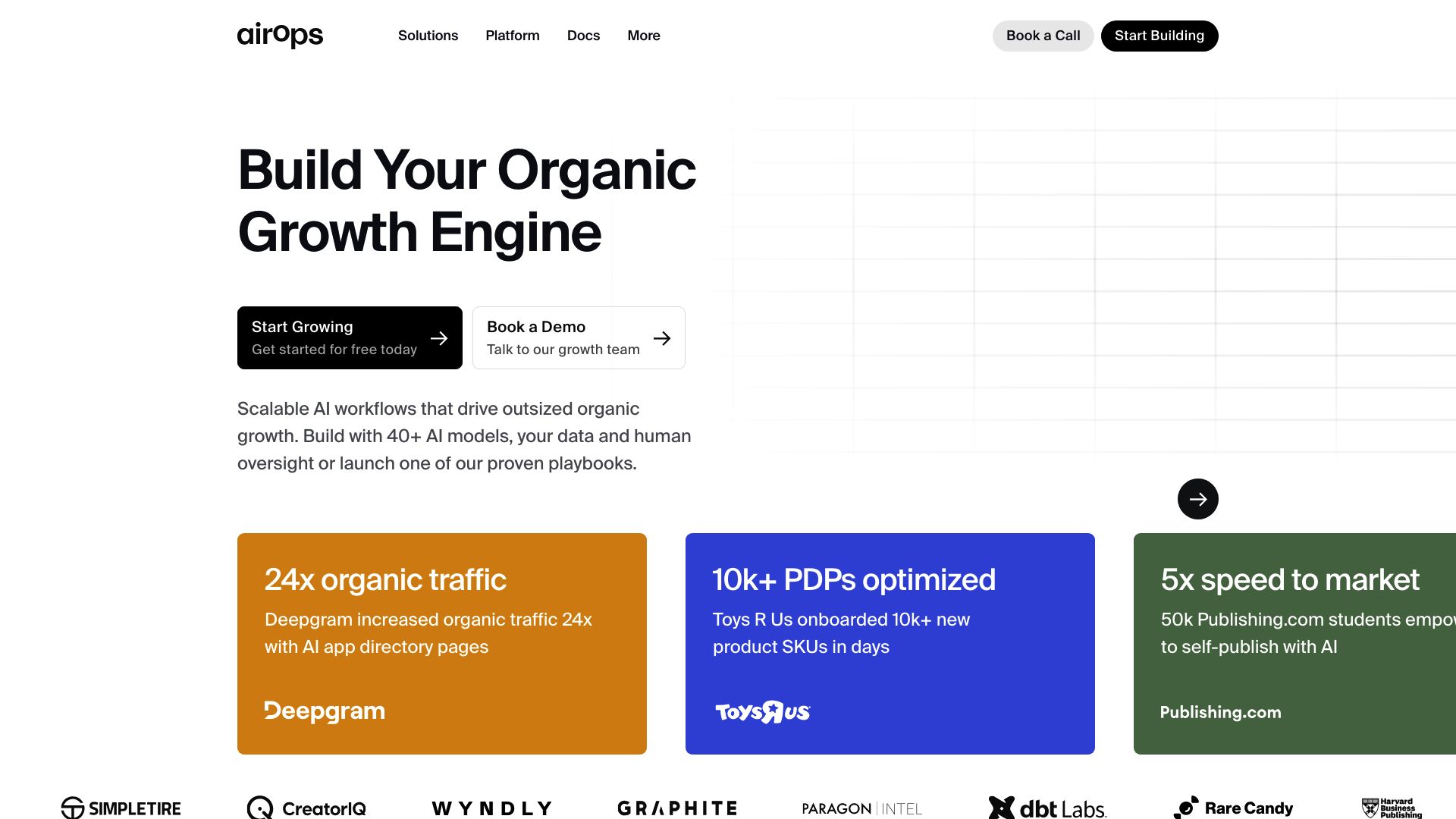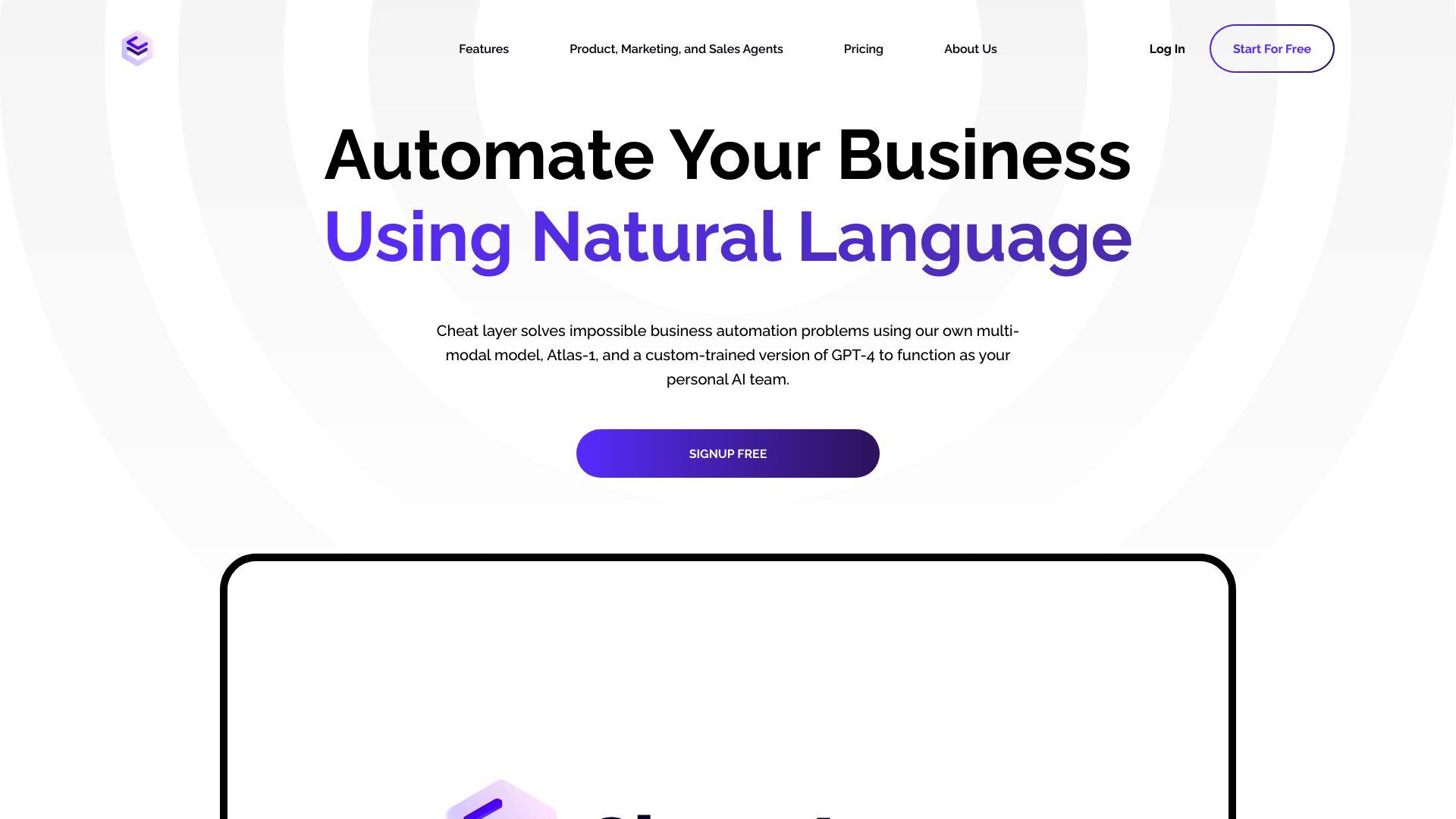AirOps vs. Cheat Layer: AI Automation Platforms Compared
AI automation platforms are transforming business operations, enabling organizations to streamline processes and boost productivity. This comparison explores AirOps vs. Cheat Layer, two powerful solutions in the AI automation space, alongside SmythOS, our cutting-edge platform. AirOps offers scalable AI workflows with extensive model integration, while Cheat Layer focuses on natural language-driven automation.
We’ll examine their key features, strengths, and limitations to help you determine which platform best suits your organization’s needs. Whether you’re a developer seeking advanced API integrations, a business leader focused on scalability and compliance, or a non-technical user looking for intuitive tools, this analysis provides insights to guide your decision-making process in leveraging AI for business growth.
AirOps Overview
AirOps empowers businesses to build scalable AI workflows that drive organic growth. The platform integrates over 40 AI models, allowing users to create custom workflows tailored to their specific needs. AirOps stands out with its proven playbooks, designed to enhance various business functions such as SEO optimization, product listing management, and content creation.


The platform’s key strength lies in its ability to handle large-scale tasks efficiently. Users can build workflows that automate complex processes, significantly reducing manual effort. AirOps showcases real-world success stories, including Deepgram’s 24-fold increase in organic traffic, demonstrating the platform’s potential to deliver tangible results.
AirOps showcases real-world success stories, including Deepgram’s 24-fold increase in organic traffic, demonstrating the platform’s potential to deliver tangible results.
AirOps offers a flexible and integrative approach, allowing users to incorporate various AI models, data sources, and human oversight into their workflows. This versatility makes it suitable for a wide range of applications across different industries. The platform’s visual builder and no-code options make it accessible to users with varying levels of technical expertise, from developers to business professionals.
While AirOps provides powerful features, users should consider potential challenges such as the learning curve associated with building complex workflows and the need for careful data management to ensure optimal performance. The platform’s effectiveness ultimately depends on the quality of data inputs and the strategic design of workflows.
AirOps continues to evolve its offerings, with products like the AI Data Sidekick helping data practitioners optimize SQL queries and build Python models more efficiently. This tool, available across multiple platforms such as dbt Cloud and Snowflake, showcases AirOps’ commitment to enhancing productivity in data-driven environments.
In the competitive landscape of AI agent builders, AirOps positions itself as a comprehensive solution for businesses looking to leverage AI for growth and efficiency. Its focus on scalable workflows and proven playbooks sets it apart, making it a strong contender for organizations seeking to automate and optimize their processes at scale.
Cheat Layer Overview
Cheat Layer revolutionizes business automation with its AI-powered platform. Built on a custom-trained version of GPT-4 and their proprietary Atlas-1 multi-modal model, Cheat Layer empowers users to create complex automations using natural language. This approach democratizes automation, making it accessible to non-technical users and small businesses.
Cheat Layer stands out with its Project Atlas Framework, which enables users to generate automations of unlimited complexity through simple conversations. This innovative approach allows users to create end-to-end solutions by interacting with the system as if speaking to an engineer, significantly reducing the technical barriers to automation.
Cheat Layer revolutionizes business automation… empowering users to create complex automations using natural language. This approach democratizes automation, making it accessible to non-technical users and small businesses.


The platform’s Semantic Targets feature ensures robust, future-proof automations that remain functional even when services update their designs. By using natural language to define automation targets, Cheat Layer creates longevity and accuracy in its solutions. Additionally, the 1-Click Cloud Agents allow users to deploy pre-built marketing and sales agents directly from their mobile devices, streamlining processes such as content generation, A/B testing, and lead generation.
Cheat Layer’s Live Mode enables iterative building and deployment of products like apps and landing pages with real-time feedback. This feature ensures that the output matches the intended goals, allowing for quick adjustments and optimizations. The platform also offers a no-code interface with a drag-and-drop editor, making automation creation accessible to users without coding knowledge.
While Cheat Layer provides powerful automation capabilities, users should be aware of potential limitations common to AI platforms, such as the need for high-quality training data and the importance of human oversight to ensure ethical use and avoid biases. However, the platform’s focus on user-friendly design and natural language interaction significantly lowers these barriers, making it an attractive option for businesses looking to leverage AI-driven automation without extensive technical expertise.
Feature Comparison
AirOps and Cheat Layer offer distinct approaches to AI-powered automation, each with unique strengths and limitations. AirOps excels in providing a comprehensive platform for building scalable AI workflows, integrating over 40 AI models and offering proven playbooks for various business functions. Its visual workflow builder and no-code options make it accessible to users with varying technical expertise. AirOps also supports multi-agent collaboration and human-AI interaction, enabling complex task automation and decision-making processes.
In contrast, Cheat Layer revolutionizes automation through its Project Atlas Framework, which allows users to generate complex automations using natural language interactions. This approach significantly lowers the barrier to entry for non-technical users. Cheat Layer’s Semantic Targets feature ensures robust, future-proof automations that adapt to service design changes. However, it may lack some of the advanced integration capabilities and extensive AI model support that AirOps offers.
While both platforms provide hosted agents and support for development and production environments, AirOps appears to offer more comprehensive debugging tools and audit logs for analytics. Cheat Layer’s focus on natural language interaction and its custom-trained GPT-4 model may provide an edge in ease of use for certain applications, but it might not match AirOps’ depth in areas like data lake support and extensive API integrations. Users seeking a balance between powerful AI capabilities and user-friendly design will find compelling options in both platforms, with the choice depending on specific project requirements and technical expertise.
Feature Comparison Table
| AirOps | Cheat Layer | SmythOS | |
|---|---|---|---|
| CORE FEATURES | |||
| Explainability & Transparency | ❌ | ✅ | ✅ |
| SECURITY | |||
| Constrained Alignment | ❌ | ✅ | ✅ |
| IP Control | ✅ | ❌ | ✅ |
| COMPONENTS | |||
| Huggingface AIs | ✅ | ❌ | ✅ |
| Data Lakes | ✅ | ❌ | ✅ |
| DEPLOYMENT OPTIONS (EMBODIMENTS) | |||
| DATA LAKE SUPPORT | |||
| Hosted Vector Database | ✅ | ❌ | ✅ |
Best Alternative to AirOps and Cheat Layer
SmythOS stands out as the premier alternative to AirOps and Cheat Layer, offering a comprehensive platform for AI agent creation and deployment. We provide a powerful yet user-friendly solution that combines the best features of both competitors while addressing their limitations.
Our drag-and-drop interface surpasses AirOps and Cheat Layer in ease of use, allowing users to build complex AI workflows without extensive coding knowledge. This democratizes AI development, making it accessible to a broader audience while still providing the depth and flexibility needed by experienced developers.
SmythOS excels in multi-agent orchestration, enabling teams of AI agents to collaborate on complex tasks. This feature enhances the efficiency and scalability of AI implementations…
We pride ourselves on our extensive integration ecosystem, supporting a wide array of APIs, AI models, and tools. This flexibility ensures that SmythOS can adapt to virtually any workflow or business process, outperforming both AirOps and Cheat Layer in versatility. Our pre-built API integrations and templates significantly reduce setup time, allowing users to focus on innovation rather than configuration.
Unlike AirOps and Cheat Layer, SmythOS excels in multi-agent orchestration, enabling teams of AI agents to collaborate on complex tasks. This feature enhances the efficiency and scalability of AI implementations, making it ideal for enterprises looking to automate sophisticated processes. Additionally, our platform offers unparalleled deployment options, allowing agents to be integrated seamlessly into existing systems across various platforms.
SmythOS combines the strengths of AirOps and Cheat Layer while offering unique capabilities that set us apart. Our commitment to user-friendly design, powerful features, and unlimited use cases makes SmythOS the superior choice for businesses and developers seeking to harness the full potential of AI technology.
Conclusion
AirOps and Cheat Layer offer powerful AI-driven automation solutions, each with unique strengths. AirOps excels in scalable AI workflows and integration capabilities, while Cheat Layer’s natural language approach simplifies complex automation for non-technical users. Both platforms demonstrate the potential of AI in enhancing business processes and driving growth.
However, SmythOS emerges as the superior choice, combining the best of both worlds and offering additional advantages. Our drag-and-drop interface rivals Cheat Layer’s user-friendliness, while our extensive integration ecosystem surpasses AirOps’ capabilities. SmythOS supports over 300,000 integrations, enabling users to create sophisticated workflows that connect seamlessly with existing tools and processes.
Unlike its competitors, SmythOS provides unparalleled flexibility in deployment options. Our ’Create Once, Deploy Anywhere’ approach allows users to build agents that can be easily integrated into multiple environments, from ChatGPT plugins to Alexa skills. This versatility, combined with our robust security features and scalability, makes SmythOS the ideal choice for businesses of all sizes looking to leverage AI effectively.
To experience the future of AI automation and unlock your business’s full potential, explore our diverse range of AI-powered agent templates or create a free SmythOS account today. With our 30-day money-back guarantee and unlimited agent creation, you can start building your AI-powered workforce risk-free. Dive into our comprehensive documentation to learn more about how SmythOS can revolutionize your approach to AI automation and drive your business forward.
Last updated:
Disclaimer: The information presented in this article is for general informational purposes only and is provided as is. While we strive to keep the content up-to-date and accurate, we make no representations or warranties of any kind, express or implied, about the completeness, accuracy, reliability, suitability, or availability of the information contained in this article.
Any reliance you place on such information is strictly at your own risk. We reserve the right to make additions, deletions, or modifications to the contents of this article at any time without prior notice.
In no event will we be liable for any loss or damage including without limitation, indirect or consequential loss or damage, or any loss or damage whatsoever arising from loss of data, profits, or any other loss not specified herein arising out of, or in connection with, the use of this article.
Despite our best efforts, this article may contain oversights, errors, or omissions. If you notice any inaccuracies or have concerns about the content, please report them through our content feedback form. Your input helps us maintain the quality and reliability of our information.
